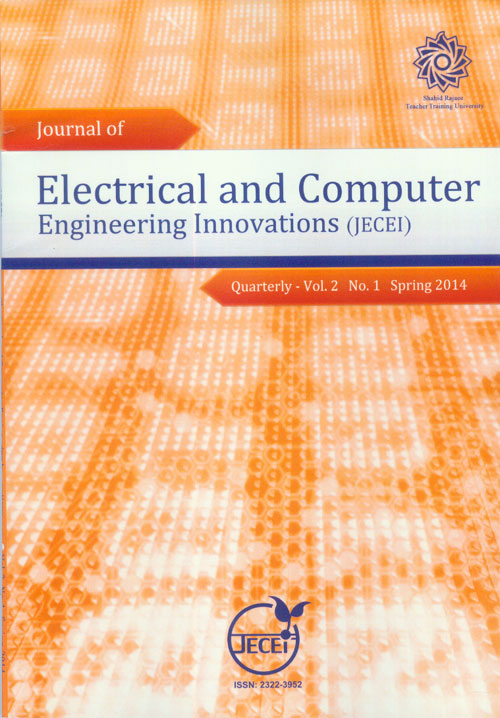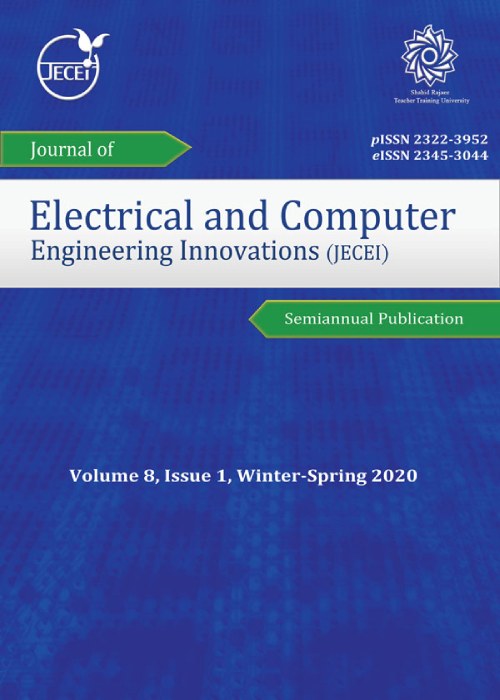فهرست مطالب

Journal of Electrical and Computer Engineering Innovations
Volume:2 Issue: 1, Winter - Spring 2014
- تاریخ انتشار: 1393/05/13
- تعداد عناوین: 6
-
-
Pages 1-5In this paper, we investigate the parameters affecting Total Harmonic Distortion (THD) and Power Supply Rejection Ratio (PSRR) in PWM Class D Amplifiers (CDAs) on the basis of linear models with feedback. From our mathematical analysis, we show that the THD of a PWM Class D amplifier with feedback can be improved by increasing the gain of the integrator through adding another amplifier at the output of the integrator. We also show that the THD can be further improved by means of two cascaded amplifiers with a single pole. We verify our analysis by means of PSPICE simulations. Simulation results show that the THD of the gain boosting and the two cascaded amplifiers with a single pole CDAs can be improved by as much as 1.4 times and 2 times, respectively.Keywords: Class, D ampliers, audio ampliers, switching ampliers, THD, distortion, pulse width modulation
-
Pages 7-13The aim of this paper is to minimize output phase noise for the pure signal synthesis in the frequency synthesizers. For this purpose, first, an exact mathematical model of phase locked loop (PLL) based frequency synthesizer is described and analyzed. Then, an exact closed-form formula in terms of synthesizer bandwidth and total output phase noise is extracted. Based on this formula, the phase noise diagram as a function of bandwidth is plotted. From the analysis and simulation results, it is observed that the synthesizer has a minimum phase noise at a particular bandwidth.Keywords: Frequency synthesizers, Phase noise, Phase, locked loop, phase noise reduction
-
Pages 15-20Renewable energy sources like wind, sun, and hydro are considered as a reliable alternative to the traditional energy sources such as oil, natural gas, or coal. This paper describes modeling and simulations to determine a method for the power performance evaluation of autonomous wind turbine system. A speed control regulator is utilized to control the DC bus voltage. The inverter gate’s signals are generated by decoding the Hall effect signals of the motor. The three-phase output of the inverter is applied to the permanent magnet synchronous generator (PMSG) block''s stator windings. This study shows that the use of resonant controllers ensures the stability of the three-phase source supplying the load which may be unbalanced and subjected to abrupt variations. It also shows that use of PI controller ensures the regulation of DC bus to a reference voltage.Keywords: Wind energy, Distributed generation, Voltage controller, PI controller
-
Pages 21-27Network environments always can be invaded by intruder agents. In networks where nodes are performing some computations, intruder agents might contaminate some nodes. Therefore, problem of decontaminating a network infected by intruder agents is one of the major problems in these networks. In this paper, we present a distributed asynchronous local algorithm for decontaminating a network. In most of prior algorithms, there is a coordinator agent that starts from a node and decontaminates the network. Since this procedure is handled by an agent and in centralized mode decontamination algorithm is very slow. In our algorithm, the network is decomposed to some clusters and a coordinator is advocated to each cluster. Therefore, there is more than one coordinator that each of them starts from different nodes in the network and decontaminates network, independently. In this case, network is decontaminated faster. In addition, in previous works the upper bound of the number of moves and the number of cleaner agents required to decontaminate network are given only for networks with special structures such as ring or tori while our algorithm establishes these upper bounds on networks with arbitrary structure.Keywords: network decontamination, mobile agents, distributed algorithm
-
Pages 29-35Nowadays the use of the Switched Reluctance Motors (SRMs) has been considerably increased in various home and industrial applications. Despite of many advantages of this type of motors, such as simple structure, low cost, and high reliability, the main disadvantage of them is the generation of high torque pulsation. This paper presents a novel method to optimize a typical SRM such that the torque ripple reaches its minimum value. Meanwhile, the torque average and the motor efficiency become maximum. It is shown that the pole width to the pole pitch ratio, for both stator and rotor poles, have a great impact on the torque ripple and torque average. Finite Element Method (FEM) is used to obtain the torque ripple, the torque average and the motor efficiency for a large number of ratios. A functional relationship is developed between the input and the output parameters. Normalized summation of the torque ripple minus the torque average and the efficiency is considered to be the cost function, which must be minimized. Then, the Particle Swarm Optimization (PSO) is used to find the optimum ratio of pole width to pole pitch, for both stator and rotor. The optimum design is verified by FEM.Keywords: Finite Element Method, Particle Swarm Optimization, Switched Reluctance Motors, Torque pulsation
-
Pages 37-42Optical Coherence Tomography (OCT) uses the spatial and temporal coherence properties of optical waves backscattered from a tissue sample to form an image. An inherent characteristic of coherent imaging is the presence of speckle noise. In this study we use a new ensemble framework which is a combination of several Multi-Layer Perceptron (MLP) neural networks to denoise OCT images. The noise is modeled using Rayleigh distribution with the noise parameter, sigma, estimated by the ensemble framework. The input to the framework is a set of intensity and wavelet statistical features computed from the input image, and the output is the estimated sigma value for the noise model. In this article the methodology of this technique is explained.Keywords: Optical Coherence Tomography (OCT), Speckle redaction, neural network, Multi, Layer Perceptron


